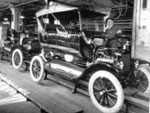At a Glance
Topics
Website
Features
Duration
Grade(s)
Lesson Format
Download
Transportation: Past, Present and Future
What pushes and pulls people into new ways of life? In this lesson, students use artifacts, documents, and photographs to help them answer this question.
Review

The Henry Ford Museum’s "Early 20th Century Migration—Transportation: Past, Present and Future" is a thematically rich teaching unit. Through artifacts, documents and photographs, students explore the overarching question, What pushes and pulls people into new ways of life? How did the lure of jobs in U.S. factories “pull” Europeans and people of the American South to northern cities and new ways of living? The lessons are both rigorous and relevant, and continuously engage students in considering the impact of the past on the present.
Dubbed an Educator DigiKit, the unit includes extensive materials for teachers. The Teacher’s Guide includes timelines on various historic themes relevant to the lesson topics, a glossary, bibliographies, connections to Michigan and national standards, and field trip suggestions. The lesson plans introduce the assembly line concept, technological and economic forces that cause large-scale migration, fair labor issues, challenges faced by immigrants, and the ongoing changing nature of work up to the present. All of the lessons include links to primary sources in the Henry Ford Museum Online Collection and they utilize a range of activities, including simulations, math-based problem solving, and source analysis.
Teachers will want to consider supplementing this unit by incorporating a rigorous, systematic approach to analyzing primary sources. Borrowing one from another site (see possibilities here) could strengthen the individual lessons and unit. A rich resource, 20th Century Migration honors middle elementary children by challenging them to ponder and interpret significant topics in history that continue to affect their world today.
Notes
| Field | Criteria | Comments | ||
|---|---|---|---|---|
| Historical Content | Is historically accurate? | Yes |
||
| Includes historical background? | Yes |
|||
| Requires students to read and write? | Yes Includes a few explicit writing exercises, primarily short-answer assessments. Class discussion questions might be used as writing prompts in older grade levels. For an example, see writing prompts for primary source analysis on page 55. |
|||
| Analytic Thinking | Requires students to analyze or construct interpretations using evidence? | Yes |
||
| Requires close reading and attention to source information? | No |
|||
| Scaffolding | Is appropriate for stated audience? | Yes |
||
| Includes materials and strategies for scaffolding and supporting student thinking? | Yes |
|||
| Lesson Structure | Includes assessment criteria and strategies that focus on historical understanding? | Yes |
||
| Defines clear learning goals and progresses logically? | Yes |
|||
| Includes clear directions and is realistic in normal classroom settings? | Yes |
|||